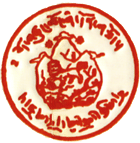ATD cover analysis
The final cover of Against the Day is pretty minimalist, depicting an aged, slightly yellowing book or manuscript in reference to the novel's setting, 1893 through World War I, and the book's mock-recreation of prose from that era.
The writing on the cover seems to cast shadows behind it. The shadows are no doubt meant to simulate the double refraction one experiences when looking through a piece of Iceland Spar, but on closer inspection the writing is not doubled, but tripled, and the typefaces are different. The upper layer is a modern sans-serif font, the middle layer is an older serif font, and the bottom layer is once again a modern sans-serif font. This may indicate that the novel straddles the period where the world moved from the 19th century into the modern age. It also may represent the book in parallel universes seen through the spar.
If we assume that the "grey" title and authors name are indeed shadows then it would seem that the shadows are cast from more than one light source - and it may be from more than two light sources too as not all the letters appear to be shifted to the same degree and direction in the "shadows". Again this may be taken as representing that the book should be viewed from - or in fact is presented as from - several different perspectives as to time, place, political position etc.
Of course it should also be borne in mind that if the grey titles and authors name were shadows, there would only be one typeface, so perhaps this is all going up the wrong path! Maybe it is merely overprinting, and the version of the book we have is the third draft of the novel, and the different typefaces somehow reflect something about the imperatives or forces behind the re-drafting.
The mysterious red seal on the cover is Tibetan, and the image in the center of the seal is a Tibetan Snow Lion in front of three mountain peaks. The Snow Lion is a mythical creature which also appears in Tibet's flag.
The generally white color of the cover ties in with the light/dark metaphor that Pynchon weaves into the novel. Perhaps the cover is also largely bare so that the "reader can decide," as Pynchon writes in the book's description, with minimal outside interference from anything but the text itself.
The book cover is designed by Michael Ian Kaye, who also designed the cover for the current paperback edition of Slow Learner. This could indicate that Pynchon likes Kaye's previous work.
We also know that an earlier version of the cover was circulated in promotional material before the novel's release. Note that in the earlier cover, the mysterious red seal looks slightly different, with the writing continuing in an unbroken circle.
What exactly the seal means is no doubt revealed in the book, but the slight changes indicate that Pynchon was probably involved in the design process, as he was with Mason & Dixon (where the ampersand was changed at his request), and the cover is thus fair game in any textual analysis.
The seal appears to be written in Tibetan language, according to somebody who posts regularly to Pynchon-l under the name "Ya Sam", who reports, at :I contacted the Tibetan Cultural Centre with the request to translate the mysterious legend on the AtD seal. They were kind enough to forward my request to the Tibetan tranlsator Tenzin Namgyal to whose generosity we owe the solution of one more ATD related mystery.
It is the Tibetan language, alright, and it means ...... Tibetan Government Chamber of Commerce.
Read their response below:
- Dear Ya Sam,
- I showed the seal you sent to our Tibetan translator, Tenzin Namgyal. He says the word to word translation is: Tibetan Government Commerce Chamber in other words: Tibetan Government Chamber of commerce. Why Pynchon has chosen to place this on the cover of his book is anyones guess. Reading the book reviews gave no insight into the reason. Perhaps after one has read it?
- Best wishes,
- Sandy Belth
- Tibetan Cultural Center
Two Covers
Additionally, the front and back covers and spine depict a "picture" of the book, Against the Day (note how the seal is broken, and the cover depicted contains fine details such as edge-rubbing and even small tears to the dust jacket at lower front edge).
This is another instance of a doubling/layering of the real and unreal, the actual and represented worlds, the past and the present. But notably, also, the cover is similar to the postcard Veikko receives from his sister in Finland (p. 84), upon which both the stamps and postmarks are "not real . . . pictures of postmarks" (which had been invalidated by the Russians). Webb calls it a Minneskort, "a postcard with a picture of what a postcard used to look like . . . ." "Memory card," Veikko clarifies, "a memory of a memory."
In yet another instance of the doubling motif, the first edition of Against the Day was issued with two different bindings beneath the dustjacket: One variant has a light green back over khaki boards, and the other variant has a red back over cream-colored boards. At this point, it still isn't clear whether this variation in the bindings is a simple matter of the availability of binding material, or whether it - like the complex dust jacket - ties into themes in the book.


